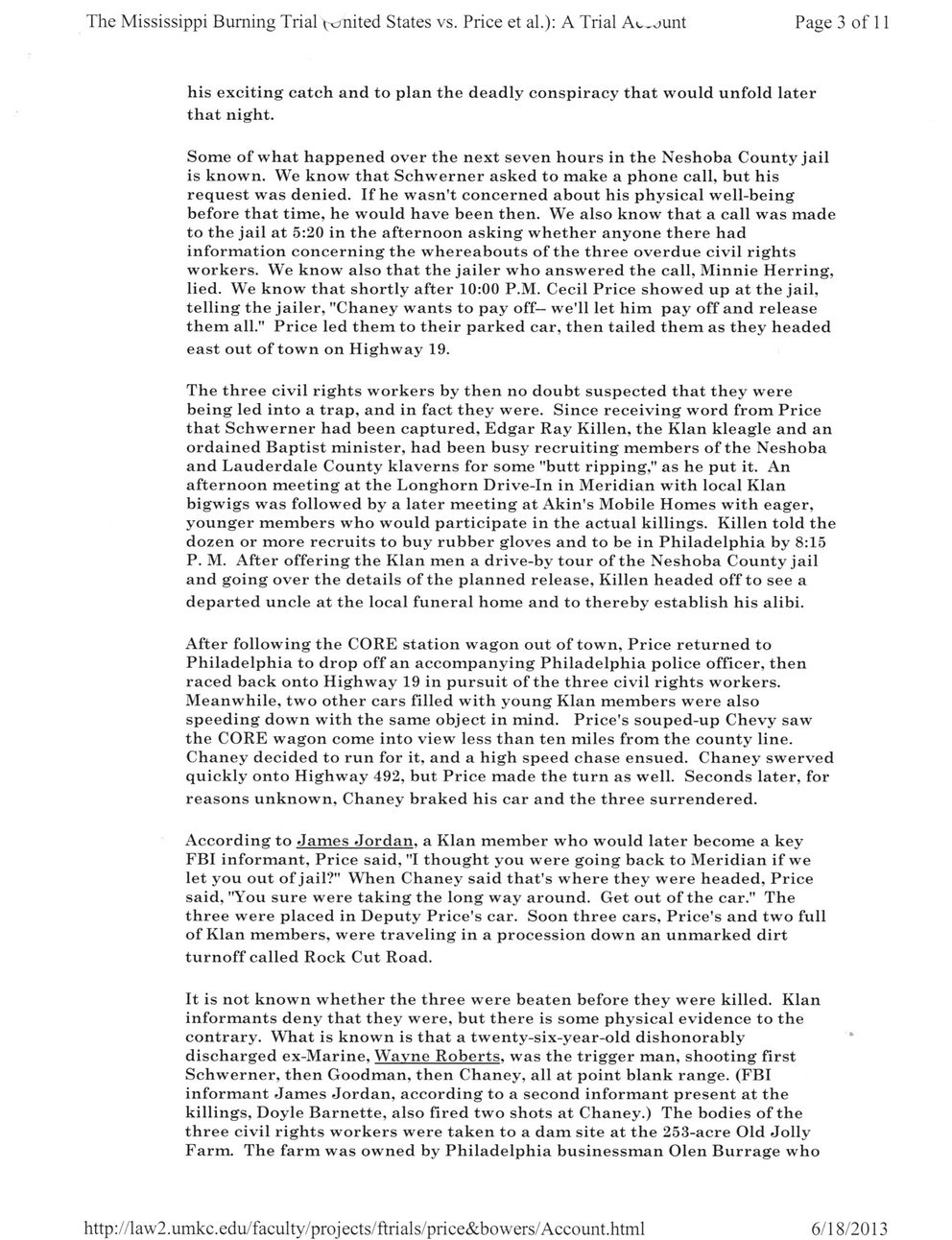This text was obtained via automated optical character recognition.
It has not been edited and may therefore contain several errors.
The Mississippi Burning Trial united States vs. Price et al.): A Trial A»__junt Page 3 of 11 his exciting catch and to plan the deadly conspiracy that would unfold later that night. Some of what happened over the next seven hours in the Neshoba County jail is known. We know that Schwerner asked to make a phone call, but his request was denied. If he wasn't concerned about his physical well-being before that time, he would have been then. We also know that a call was made to the jail at 5:20 in the afternoon asking whether anyone there had information concerning the whereabouts of the three overdue civil rights workers. We know also that the jailer who answered the call, Minnie Herring, lied. We know that shortly after 10:00 P.M. Cecil Price showed up at the jail, telling the jailer, "Chaney wants to pay off— we'll let him pay off and release them all." Price led them to their parked car, then tailed them as they headed east out of town on Highway 19. The three civil rights workers by then no doubt suspected that they were being led into a trap, and in fact they were. Since receiving word from Price that Schwerner had been captured, Edgar Ray Killen, the Klan kleagle and an ordained Baptist minister, had been busy recruiting members of the Neshoba and Lauderdale County klaverns for some "butt ripping," as he put it. An afternoon meeting at the Longhorn Drive-In in Meridian with local Klan bigwigs was followed by a later meeting at Akin's Mobile Homes with eager, younger members who would participate in the actual killings. Killen told the dozen or more recruits to buy rubber gloves and to be in Philadelphia by 8:15 P. M. After offering the Klan men a drive-by tour of the Neshoba County jail and going over the details of the planned release, Killen headed off to see a departed uncle at the local funeral home and to thereby establish his alibi. After following the CORE station wagon out of town, Price returned to Philadelphia to drop off an accompanying Philadelphia police officer, then raced back onto Highway 19 in pursuit of the three civil rights workers. Meanwhile, two other cars filled with young Klan members were also speeding down with the same object in mind. Price's souped-up Chevy saw the CORE wagon come into view less than ten miles from the county line. Chaney decided to run for it, and a high speed chase ensued. Chaney swerved quickly onto Highway 492, but Price made the turn as well. Seconds later, for reasons unknown, Chaney braked his car and the three surrendered. According to James Jordan, a Klan member who would later become a key FBI informant, Price said, "I thought you were going back to Meridian if we let you out of jail?" When Chaney said that's where they were headed, Price said, "You sure were taking the long way around. Get out of the car." The three were placed in Deputy Price's car. Soon three cars, Price's and two full of Klan members, were traveling in a procession down an unmarked dirt turnoff called Rock Cut Road. It is not known whether the three were beaten before they were killed. Klan informants deny that they were, but there is some physical evidence to the contrary. What is known is that a twenty-six-year-old dishonorably discharged ex-Marine, Wayne Roberts, was the trigger man, shooting first Schwerner, then Goodman, then Chaney, all at point blank range. (FBI informant James Jordan, according to a second informant present at the killings, Doyle Barnette, also fired two shots at Chaney.) The bodies of the three civil rights workers were taken to a dam site at the 253-acre Old Jolly Farm. The farm was owned by Philadelphia businessman Olen Burrage who http://law2.umkc. edu/faculty/projects/ftrials/price&bowers/Account.html 6/18/2013

Ku Klux Klan Mississippi-Burning-Trial-(3)